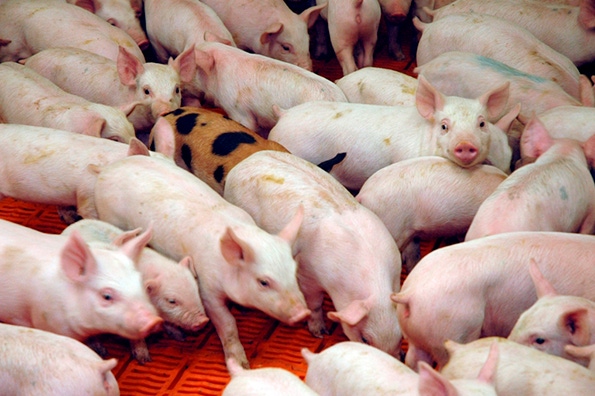Sodium metabisulfite improves ADG in low-toxin diets
Further research should be conducted to determine the biological mechanism of sodium metabisulfite in low-deoxynivalenol diets.
August 23, 2018

By Dwight J. Shawk, Steve S. Dritz, Robert D. Goodband, Mike D. Tokach, Jason C. Woodworth and Joel M. DeRouchey, Kansas State University
Deoxynivalenol or vomitoxin, is a mycotoxin found in cereal grains and is produced by the Fusarium genus. The deoxynivalenol concentration of cereal grains can vary from year to year, based on the degree of stress the plant is exposed to during the growing season, such as poor soil fertility, harsh weather conditions and insect damage.
Swine are sensitive to DON with exposure to concentrations greater than 1 part per million resulting in decreased feed intake and growth, while exposure to higher concentrations can result in complete feed refusal and vomiting. Although not approved by U.S. Food and Drug Administration as deoxynivalenol detoxifying agents, sodium metabisulfite-based feed additives have been used in diets with high deoxynivalenol concentrations with positive results. A positive relationship between growth performance and the addition of sodium metabisulfite-containing feed additives in swine diets with greater than 3 ppm of deoxynivalenol.
There is limited research available to document the effects of sodium metabisulfite-based feed additives on growth performance of nursery pigs fed diets with relatively little to no deoxynivalenol. Therefore, we conducted an experiment to determine the effects of sodium metabisulfite-based feed additives in low-deoxynivalenol containing diets on the growth performance of nursery pigs. We compared a commercially available feed additive containing sodium metabisulfite from Provimi to pure food grade sodium metabisulfite in diets that did not contain detectable concentrations (<0.5 ppm) deoxynivalenol.
In this experiment, 2,808 pigs (PIC 337 × 1050; initial weight 15 pounds) were used in a 28-day growth trial. Pigs were weaned at approximately 22 days of age and were randomly sorted into one of 104 pens (52 pens of barrows, 52 pens of gilts) with one pen of gilts and one pen of barrows per fence line feeder. All pigs were fed a common Phase 1 diet for seven days, then seven days after weaning, considered Day 0 of the trial, a pair of pens (one adjoining feeder) were blocked by weight and randomly assigned to one of four dietary treatments with 13 feeders per treatment. Dietary treatments were fed for 28 days. The four treatments were: 1) a control diet; 2) control diet with 0.50% commercial product from Day 0 to 21 followed by 0.25% commercial product from Day 21 to 28; 3) control diet with 0.25% sodium metabisulfite from Day 0 to 28; and 4) control diet with 0.50% sodium metabisulfite from Day 0 to 21 followed by 0.25% sodium metabisulfite from Day 21 to 28.
Chemical analysis of the diets indicates that dietary deoxynivalenol concentrations, regardless of phase, were less than 0.5 ppm or below the detectable limit.

Table 1: Effects of added sodium metabisulfite or Provimi product on growth of nursery pigs.
From Day 0 to 28, pigs fed diets containing the commercial product or 0.50% sodium metabisulfite had greater (P < 0.05) average daily gain compared to pigs fed 0.25% sodium metabisulfite or the control diet. Pigs fed the commerical product or 0.50% sodium metabisulfite had increased (P < 0.05) average daily feed intake compared to pigs fed the control, with pigs fed the 0.25% sodium metabisulfite intermediate. Pigs fed 0.50% sodium metabisulfite had improved (P < 0.05) F/G compared with pigs fed the control diet, with those fed the Provimi product intermediate. Pigs fed 0.25% sodium metabisulfite had poorer (P < 0.05) F/G compared to pigs fed the other treatments. Pigs fed 0.50% sodium metabisulfite or the commercial product had greater (P < 0.05) Day 28 bodyweight than pigs fed the other dietary treatments.
In conclusion, in diets relatively low in deoxynivalenol, pigs fed sodium metabisulfite-based preservatives had improved average daily gain compared to pigs fed a control diet. The mode of action for the improvement in performance in diets with low levels of deoxynivalenol is unclear. In high-deoxynivalenol diets, the biological mechanism of sodium metabisulfite is suggested to be the chemical alteration of deoxynivalenol to a nontoxic form.
Sodium metabisulfite is commonly used in the food industry as an antioxidant and antimicrobial agent. Previous research has indicated improvements in energy and protein utilization in broilers fed steam pelleted sorghum-based diets with sodium metabisulfite. Further research should be conducted to determine the biological mechanism of sodium metabisulfite in low-deoxynivalenol diets.
You May Also Like



